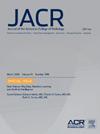The Value of Radiology Consultation: Effort Allocation, Clinical Impact, and Untapped Opportunities
IF 5.1
3区 医学
Q1 RADIOLOGY, NUCLEAR MEDICINE & MEDICAL IMAGING
引用次数: 0
Abstract
A substantial proportion of work in radiology involves activities beyond the primary interpretation of imaging. In this review, the authors discuss the current state of consultative work in radiology and evaluate potential strategies for more equitable reimbursement of these activities. “Noninterpretive” or “consultative” activities may constitute 35% to 60% of work hours. These activities routinely impact patient care; for example, changes in management are seen with 3-9% of radiologist-protocoled exams, 8-37% of secondary interpretations, 12-55% of ad-hoc (“curbside”) consultations, and 8-58% of multidisciplinary conferences. Currently, ad hoc and multidisciplinary consultations are not associated with formal mechanisms for documentation or billing, despite together constituting 10% to 15% of radiologists’ work hours. Existing and future mechanisms, however, could help bridge this gap. Practice in radiology might benefit from dedicated consultation Current Procedural Terminology billing codes, similar to those already in place for consultations in pathology. Existing non–face-to-face (electronic) consultation codes represent a potential stopgap solution. Practices may alternatively negotiate compensation for noninterpretive tasks as part of a value-based reimbursement model. Any viable solution would need to account for the opportunity cost of time spent on nonbillable activities (usually >5 work relative value units/hour). Consultation is likely to play an increasingly important role in the future of radiology with advances in imaging and artificial intelligence–based technologies. Individual radiologists and group practices would benefit from recognizing and leveraging the value of their consultative work.
放射学会诊的价值:努力分配、临床影响和未开发的机会。
放射学中相当大比例的工作涉及的活动超出了对成像的初步解释。在这篇综述中,作者讨论了放射学咨询工作的现状,并评估了这些活动更公平报销的潜在策略。“非解释性”或“咨询性”活动可能占工作时间的35%至60%。这些活动通常会影响患者护理;例如,在3-9%的放射科医师协议检查、8-37%的二次解释、12-55%的临时(“路边”)咨询和8-58%的多学科会议中可以看到管理方面的变化。目前,尽管临时会诊和多学科会诊合计占放射科医生工作时间的10%至15%,但并没有正式的记录或计费机制。然而,现有和未来的机制可以帮助弥合这一差距。放射学的实践可能受益于专门的会诊当前程序术语计费代码,类似于那些已经到位的病理会诊。现有的非面对面(电子)咨询代码是一种潜在的权宜之计。实践可以选择协商非解释性任务的补偿,作为基于价值的补偿模型的一部分。任何可行的解决方案都需要考虑花费在不可计费活动上的时间机会成本(通常是每小时50个工作相对价值单位)。随着成像和基于人工智能的技术的进步,会诊可能在放射学的未来发挥越来越重要的作用。个体放射科医生和团体实践将受益于认识和利用他们的咨询工作的价值。
本文章由计算机程序翻译,如有差异,请以英文原文为准。
求助全文
约1分钟内获得全文
求助全文
来源期刊

Journal of the American College of Radiology
RADIOLOGY, NUCLEAR MEDICINE & MEDICAL IMAGING-
CiteScore
6.30
自引率
8.90%
发文量
312
审稿时长
34 days
期刊介绍:
The official journal of the American College of Radiology, JACR informs its readers of timely, pertinent, and important topics affecting the practice of diagnostic radiologists, interventional radiologists, medical physicists, and radiation oncologists. In so doing, JACR improves their practices and helps optimize their role in the health care system. By providing a forum for informative, well-written articles on health policy, clinical practice, practice management, data science, and education, JACR engages readers in a dialogue that ultimately benefits patient care.
 求助内容:
求助内容: 应助结果提醒方式:
应助结果提醒方式:


